Holiday Budget System Buyers' Guide
by Zach Throckmorton on November 8, 2011 12:00 AM ESTMotherboards and Features
As mentioned earlier, Cougar Point chipset-based motherboards are fully diversified into every cost niche of the motherboard market. While cutting-edge, flagship motherboards garner the most attention from enthusiasts, inexpensive, no-frills boards are generally just assumed to all be more or less equivalent in performance. But does performance vary between these budget boards? We briefly benchmark a few important motherboard features: LAN, SATA, and USB 2.0 throughput. But before we get to the benchmarks, let's compare features.
I tested eight different budget motherboards—four socket AM3 with AMD chipsets, one FM1 with the A55 chipset, and three based on Intel chipsets (all LGA 1155). Here's a quick rundown of the various features for each board.
| Product |
Platform/ Chipset |
Price |
RAM slots |
Rear USB ports |
LAN |
Graphics ports |
SATA ports |
Expansion slots |
| ASRock A55M-HVS |
FM1 / A55 |
$59 | 2 | 6 USB 2.0 | 1Gb | VGA, HDMI | 6 |
1xPCIe x16 1xPCIe x1 1xPCI |
| ASRock 880GM-LE |
AM3 / 880G + SB710 |
$55 | 2 | 6 USB 2.0 | 1Gb | VGA, DVI | 6 |
1xPCIe x16 1xPCIe x1 2xPCI |
| Biostar A780L3L |
AM3 / 760G + SB710 |
$50 | 2 | 4 USB 2.0 | 100Mb | VGA, DVI | 4 |
1xPCIe x16 2xPCI |
| Biostar A870U3 |
AM3 / 870 + SB850 |
$70 | 4 |
2 USB 2.0, 2 USB 3.0 |
1Gb | VGA, DVI | 6 (6Gb) |
1xPCIe x16 1xPCIe x4 2xPCIe x1 2xPCI |
| MSI 760GM-P33 |
AM3 / 760G + SB710 |
$55 | 2 | 4 USB 2.0 | 1Gb | VGA | 6 |
1xPCIe x16 2xPCIe x1 1xPCI |
| ASRock H61M-VS |
LGA1156 / H61 |
$54 | 2 | 6 USB 2.0 | 100Mb | VGA | 4 |
1xPCIe x16 1xPCIe x1 |
| Biostar H61ML |
LGA1156 / H61 |
$60 | 2 | 4 USB 2.0 | 100Mb | VGA, DVI | 4 |
1xPCIe x16 1xPCIe x1 2xPCI |
| MSI H61M-P21 |
LGA1156 / H61 |
$55 | 2 | 4 USB 2.0 | 100Mb | VGA | 4 |
1xPCIe x16 3xPCIe x1 |
One thing to note is that of the above motherboards, Biostar and MSI offer 3-year warranties while ASRock offers a 1-year warranty. As you can see, in general, you'll get more for your money from an AMD-based motherboard than an Intel-based motherboard. That is, none of the Intel boards offer Gigabit ethernet, and only one offers DVI in addition to VGA connectivity; the FM1 board is also the only board with an HDMI port. Do the Intel platforms instead offer better performance? Let's find out.
Benchmarks
While we did not perform thorough testing like when we review a specific motherboard, we tested three important metrics for all eight boards: USB 2.0 performance, SATA throughput, and LAN performance.
USB 2.0 performance
We used a Mushkin Ventura Pro USB 3.0 flash drive and CrystalDiskMark 3 to test the sequential write and read speeds of a 1000MB file. While the Intel boards tend to perform better than the AMD boards, the differences here are very minor and would likely not be noticeable in real world scenarios. The single USB 3.0 equipped board would of course be able to run quite a bit faster with an appropriate USB 3.0 flash drive.
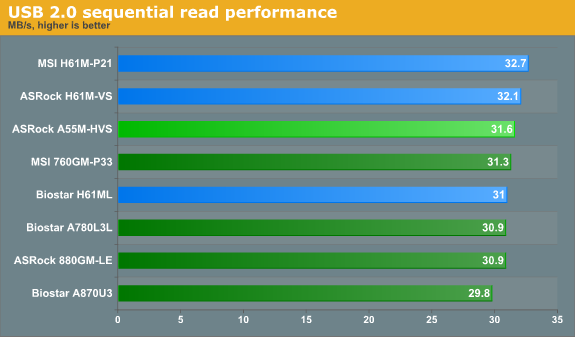
SATA performance
To test SATA performance, we again used CrystalDiskMark 3 to measure the sequential write and read speeds of a 1000MB file—with a Patriot Pyro 120GB SSD. This SSD is one of today's top performers and costs nearly $200—well above the budget sector. However, prices on SSDs will only fall as time passes, and this SSD illustrates what these boards are capable of better than a mechanical HDD. From these results, it's clear that all of the boards perform very similarly in terms of SATA throughput.
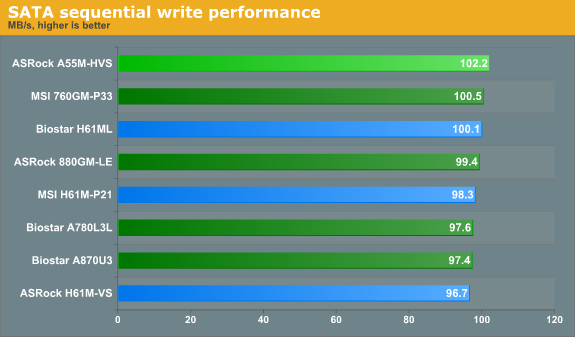

LAN performance
LAN Speed Test is a freeware program designed for testing the network connection between two PCs on a home network. The speed of the transfer is limited by the lowest common denominator on the network, so if you have gigabit ethernet capable computers but a 100 Mbit capable router, you are limited to 100 Mbit transfer. For this test, we use LAN Speed Test to transfer a 1000 MB file across a home network with a 100 Mbps lowest common speed to the same machine each time, in a write/read scenario. It is critically important to note that if you plan on attaching any of the Intel Cougar Point chipset-based boards in this guide to a network, you will be limited to 100 Mbps transfers as none of them have Gigabit adapters.
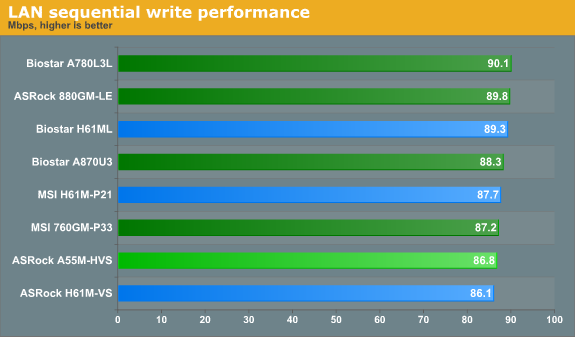
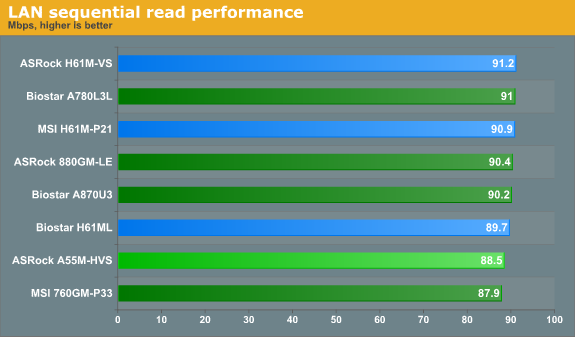
From these benchmarks, it appears that the budget boards are mostly equivalent performers. I was heartened to experience neither anomalous behaviors nor frustrating issues with any of the boards in the course of testing. Though it's somewhat disappointing to not find a hidden gem, it is useful to know that many budget boards are solid performers—so savvy consumers can watch for sales and rebates.
We cover the rest of the system components on the next page.


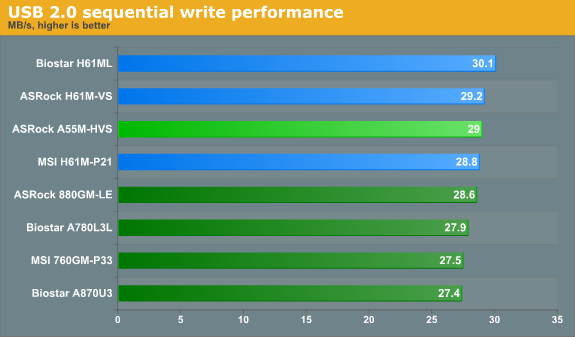








95 Comments
View All Comments
vitaminwater - Tuesday, November 8, 2011 - link
1st time poster, long time lurkera AMD x2 in this day an age?? you can get a Athlonx4 955 black editon for $120 shipped
for a couple of bucks more you get MONSTER performance for a budget build
just my 2cents
keep up the good work!
JarredWalton - Tuesday, November 8, 2011 - link
$120 is twice the cost of the Athlon X2, and at that price you could also get the Llano A8 processors or an i3-2100. You could also add a discrete GPU for the same $60 increase, or some other upgrades like a better display. Given the higher power requirements of the 955BE relative to other choices, I'm not sure it's any more sensible than an inexpensive Athlon II X2.jefeweiss - Tuesday, November 8, 2011 - link
It seems like part of the problem with the comparison of the low end A4 part is that it should be compared to a system that is comparable in cost of both CPU and graphics, because you get both with the Llano parts. The cost of the Celeron plus the 5670 discrete graphics or the Athlon II plus 5670 discrete card would give you enough money to buy a much nicer Llano processor. Otherwise, it doesn't make sense to compare the Llano to the other two with discrete graphics, you would have to use integrated graphics. Part of the value proposition of the Llano is that you can game on a system and not have to buy a discrete card, or at least that was my understanding.Wierdo - Tuesday, November 8, 2011 - link
Yeah that was strange, are we comparing products we can buy for X price, or not? Makes no sense.mczak - Tuesday, November 8, 2011 - link
The gpu of the a4 is not anywhere close to a HD 5670 however - there's a reason its gpu is called HD 6410 (not even the a8-3850 is really close to that fwiw more like HD 5570)... I guess it should be quite comparable in performance to a HD 6450, it has significantly less shader power (thanks to much lower clock) but it possibly can make up this loss with its higher memory throughput (of course not against the HD 6450 gddr5 but these aren't available anyway).Granted the price difference between a HD 6450 and HD 5670 is not really all that large - but the 3d performance of the A4 is going to be low enough that you can't really say it comes with both cpu and graphics but the celeron does not (yes the HD 2000 will be slower, a HD 3000 such as in the i3-2105 could however possibly challenge it).
mino - Wednesday, November 9, 2011 - link
Well, the Celeron, or any Intel for that matter, has no proper 3D drivers.So no it does not come with a GPU. Even a Radeon 9700 from 2002 has more "GPU" in itself.
Paul Tarnowski - Tuesday, November 8, 2011 - link
Haven't yet read anything beyond the first page, but I'd say the problem in your thinking is that budget builders are going to want to spend the extra dosh. In fact, most budget builds are extremely tight. When I'm wearing my system builder hat I have to be very careful when building these things. For the price of your 955 I can get both CPU and motherboard.It's just not going to be much of a gaming build. Budget PCs aren't meant for gaming.
MonkeyPaw - Tuesday, November 8, 2011 - link
I think Microcenter is probably the best kept secret in CPU pricing, as they actually regularly check and try to beat Newegg pricing. For example, they are selling the G530 for $39.99 as I type this. They are also selling OEM Phenom II X4 830s for $49.99. If you need a retail model, the 840 is $10 more. That would probably be my first choice for a "budget CPU" right now unless absolute efficiency was the goal. At least you can overclock them still.Roland00Address - Tuesday, November 8, 2011 - link
Phenom 830 is a true phenom II x4 with 2.8 ghz, 2mb l2 cache, and 6mb l3 cachePhenom 840 is a rebrand athlon II x4 with 3.2 ghz, 2mb l2 cache and 0mb l3 cache.
Agreed that microcenter is awesome.
TrackSmart - Tuesday, November 8, 2011 - link
Agreed x 2. $50 for a 2.8 - 3.0 GHz quad core is the way to go (assuming you have access to a MicroCenter store. I think they advertise that deal every week. It makes me want to build a system, even though I have no need for another one, just because it's such a goo deal. And I guess that's the point.